| |
Upcoming December EFO Meeting
The December EFO Meeting will be held at 9:00 p.m. on Saturday, December 6 at the Oakland Yard Dome in Waterford, MI. The Oakland Yard is located on M-59, Highland Rd., just east of Airport Rd.
All current EFO members will have their $1 entry fee reimbursed. If you wish to fly, and you are not a member of the Oakland Yard flying club, the fee is $15 for the night. Only indoor and park flyers are flown in the dome.
Everyone is invited to join us, but you will need your AMA card and the "proper" type of plane to fly.
See you inside in December.
Return to "What's In This Issue?"
New Online RC Site
(informational only)
Dear fellow R/C enthusiast,
RCBay.net, the web's newest, and soon to be the best R/C website is on-line and waiting for you!
RCbay.net brings you familiar discussion forums and FREE SWAP SHOP along with a new wrinkle that will help you STRETCH YOUR HOBBY DOLLARS TO THE MAX! What's this?.. The "Super Deal Network" - our way of making RCbay.net pay off for you in real dollars!
RCbay.net has been created by lifelong modelers who know what an R/C site should be about.. FUN!
Coming features include Dear Jake: Advice for the Propworn, Duey Lee's Helicopter column, and much much more!
Yes, RCbay.net will have commercial sponsorship, but never a pop-up or other annoyance that gets in your way. Sponsors such as PowerfLite - Skyborn Electronics, and Brison R/C Engines are located in the "Specialty Manufacturer Listings" where you can find them when you want to. These sponsors, and others, will be offering special deals and promotions for RCbay.net members only, via email, through the site. Your email address remains confidential to Rcbay.net.
The larger the membership the more sponsors will want to participate. Every membership helps!
Please stop by and join today. It's absolutely free, and just takes a minute to register. Once registered you will be eligible to win the October Membership Prize (to be announced.. The September prize was a new Thunder Tiger .46 Pro engine provided by Mike's Hobby Shop Superstore in Dallas, Tx.).
We ask for your help in getting us "over the hump" by joining and posting as soon as you have time. It will be much appreciated and you will ensure your status as a "Charter Member" as RCbay.net grows to become the best R/C community on the web!
Thanks in advance for being a part of www.RCbay.net! We hope to see you on the site soon... until then... Blue skies and light winds.
Mike Cunningham - "Bipeman" (Bipeman@rcbay.net)
Editor: www.RCbay.net
Return to "What's In This Issue?"
New Easy Battery Removal System from DJ Aerotech
This Notice Originally Appeared on the EFLIGHT list:
From Don Stackhouse djaerotech@erinet.com
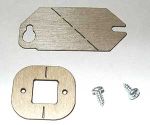
Photo from DJ Aerotech Website
After all the recent controversy about safety issues with Li-poly batteries, we got to thinking about what we could do to help the situation.
One piece of very good advice is to remove the battery from the airplane before charging, and then charge it in a fireproof container of some sort.
I used to put the battery in a covered Pyrex dish, but lately I've been following Fred Marks' advice and sticking the battery in our oven.
However, the key to all of this is having an efficient way to remove and reinstall the battery.
I personally do not like hook-and-loop fasteners such as "Velcro" for this purpose. They're bulky, can be relatively heavy, and really are not all that secure, especially at the "G" forces that some of our more aerobatic Roadkill Series models can pull with a 3-cell pack. Some of the things I do with the Triplane, the Ryan ST or some of the others currently in development could quite conceivably pull a battery loose from a piece of Velcro. Tape is lighter and more secure, but is definitely not very convenient for removing and reinstalling the battery.
Instead, we came up with a neat little laser-cut plywood plate that glues or tapes to the battery. The ply plate has keyhole slots in it for slipping onto two small screws. Just loosen the screws half a turn each, and you can slip the battery off of the screws through the keyhole slots in the plate.
After charging, just slip the plate back into place and tighten the screws back down. Quick, simple, light and very secure.
The mounting kit is designed to adapt to a variety of battery sizes, up through about 1200 mAh 3-cell packs. The big factor is the amount of weight you can safely support with the mounting plate; with enough additional mounting plates you can probably support larger batteries.
The mounting kit includes CAD-drawn instructions, the battery mounting plate, two screws and a pair of plywood plates to glue to the model to hold the screws if the surface you're mounting to is something that won't hold screws by itself, such as balsa. Retail price is $1.25 plus shipping, and dealer inquiries are welcome.
The mounting kit can probably be used for convenient mounting of other types of components as well, such as small servos. I'll leave that up to your ingenuity.
For more info, photos and ordering, please visit the "Products" section of our website.
Don Stackhouse at DJ Aerotech djaerotech@erinet.com
Website: www.djaerotech.com
This is the biggest and best swap meet in southeastern Michigan!
Return to "What's In This Issue?"
Electric Power for the Wing Mfg. A-26
From a question by Larry Lewis of Florida
"Looking for recommendations for a power system for the subject aircraft. 68" wing, 748 sq inches, 10 lbs. symmetrical wing.
I am currently building a wing mfg A-26 and trying to keep it light. Suggestions welcome.
(Be sure to read Keith Shaw's Talk to the EMFSO for building/lightening tips. You'll find it at members.aol.com/kmyersefo/page3.htm
You'll also find Keith's article on Twins there as well. KM)
I would like to fly this plane with brushless motors, questions:
How do you sync two motors?
Should I use one ESC to drive both motors? Concerned about long leads and interference.
Should I use two ESC's, one on each motor driven by the same receiver channel? Concerned about driving two ESC's from a single channel.
I believe you have written about twins but have been unable to locate the info."
After responding about the dual ESC's, I received the following:
"Ken there seems to be a consensus on dual ESC's. See the email below I received today from hobby-lobby. I would like your opinion re: motor selection, optical controller. I understand the BEC issue. Still wondering how to sync the motors. You can approximate the motor's performance in ElectriCalc with these specs: 282010: RPM/V: 1100, Resistance: 42 mOhms, I Zero: 2.8 Max. current allowable: 40A/60sec., Max. efficiency current is 20 to 30A.
I have run this data in MotoCalc, the results indicate very poor performance.
Larry's letter to Hobby Lobby:
Gentlemen,
I am so pleased with my AXI motor in Bonnie I would like to use them in my new plane, now under construction.
It is a Wings Mfg A-26. 748 square inches of wing, weight 6-7 lbs. If your AXI 282010 will fly a 5 lb plane with authority will two fly a 6-7 lb twin? It seems clear that your 412014 would work but the cost differential is significant.
I am asking your opinion; this is not a request for a guarantee. What I purchase is my responsibility not yours. I add this to remove you from all liability for answering this question/opinion or following your recommendation.
I want you educated and knowledgeable opinion/recommendation.
Larry
Hobby Lobby's response:
LARRY,
TWO OF THE AXI2820/10 MOTOR WILL HAVE MORE THAN ENOUGH POWER FOR THE A-26 YOU ARE BUILDING. WITH AN AIRPLANE OF THAT SIZE, YOU SHOULD BE ABLE TO CARRY ALL THE BATTERY POWER YOU WILL NEED FOR THE TWIN.
BE AWARE THAT YOU WILL NEED A CONTROLLER FOR "EACH" MOTOR, AND IF YOU ARE GOING TO USE THE BEC CIRCUIT, YOU WILL HAVE TO DISABLE THE BEC CIRCUIT ON ONE OF THE MOTOR CONTROLLERS. A BETTER CHOICE WOULD PROBABLY BE TO USE THE OPTO CONTROLLERS, AND USE AN "ULTIMATE BEC", PART NO KFS001, TO SUPPLY POWER TO YOUR RECIEVER. THE ULTIMATE BEC WILL SUPPLY AS MUCH AS 5 AMPS TO THE RADIO. THIS IS MORE THAN ENOUGH TO POWER ALL THE SERVOS YOU WILL HAVE ON THE A-26.
YOURS,
L.A. JOHNSTON"
I checked the Wing Mfg. Website (www.wingmfg.com) and found the following data:
Wing Area: 748 sq.in., Dry Weight less flaps & retracts: 7 1/2 lbs. (120 oz.) as tested with twin 40 engines and 6 channel radio. Tower Hobbies lists the OS FX 40 w/muffler weight as 16.84 oz. The pair would be 33.68 oz. Since this version is less flaps and retracts, my guess is that it could be a 4 or 5 servo plane. For a standard receiver, 4 standard servo, 600 mAh battery pack flight system, a good onboard radio estimate would be about 11 oz. (120*0.95) - 33.68 - 11 = a completed airframe weight of about 69 or 70 ounces. For simple figuring, the finished plane might weigh twice as much as the completed airframe weight or 140 oz. That is 8.75 lb.
What would the minimum input power be? 8.75 * 50 watts = 437.5 watts. Anything over that would be added performance. Another way to look at it is using Orme's Rule. Minimum number of cells = 748 / 50 = 15 cells. Ken's performance number of cell = 748 / 30 = 25 cells. The average of these two numbers is 20 cells. Comfortably, that is 25 amps * 20 cells = 500 input watts. It can be more. It can be less.
Putting the plane together as an electric project:
Completed Airframe Weight: 70 oz.
Airborne Radio System Weight:
Receiver: FMA Quantum 6 Sub Micro Receiver 0.5 oz.
Servos: 5 Hitec HS-85 0.7 oz. ea. 3.5 oz.
Rx Battery: 270 mAh 2.05 oz.
ESC: Astro Flight 204D 1.4 oz.
Total airborne radio system w/fudge factor: 7.9 oz.
Motors: AF035G 8 oz. ea. 16 oz.
Power Battery: 20 Sanyo CP-2400SCR 2.11 oz. ea. 42.2 oz.
AUW inc. fudge factor of 5% = 143 oz.
Prop diameter = (SQRT ((143 / 2 * 1.15) / Pi)) * 2 = 10.2" or a 10 inch prop.
Prop pitch = 10 * 0.65 = 6.5" or a 6" or 7" pitch
An Astro Flight 035 brushed motor geared 2.82:1 pulls about 28 amps with a Master Airscrew standard wood 10x6 prop. (I use that setup in my TigerShark.) Therefore the input power for this system would be about 560 watts.
At 143 oz. the data looks like this:
Wing Loading = 27.3 oz./sq.ft.
Weight Factor = 3
Power Factor = 2.3
Watts for level flight = 243
The plane would fly like this, but the "ideal" would have a Weight Factor closer to 2.7 and Power Factor closer to 3. The biggest problem is that the completed airframe is heavy.
The first thing to do would be to try and reduce the completed airframe weight using Keith Shaw's techniques as outlined in his talk to the EMFSO, as noted above.
Replacing the molded high impact cowls and cowl flap sections and the molded top fairing with vacuum formed or lightly built up parts could save some weight, as well as some wood substitutions, restructuring and covering with iron-on film. If there was a 10% reduction in weight by good building practices, then the completed airframe weight could be about 67 oz.
By changing the cells in the system pack to Sanyo CP-1700SCR 1700 mAh cells, the weight of the battery pack would be reduced by about 10 oz.
If the 67 oz. completed airframe weight is reached and CP-1700's are used, AUW could be about 126 oz. or 7.9 lb.
The data would then look like this:
Wing Loading = 24 oz./sq.ft.
Weight Factor = 2.7
Power Factor = 2.9
Watts for level flight = 193
This is much closer to the "ideal" sport/sport scale plane.
Larry specifically asked about using brushless. He wants to use the AXI 2820/10. Using this brushless motor would only save about 3 oz. total over the AF035G's geared 2.82:1 because of the heavier speed controls for the brushless. It would be complicated by having to run two ESC's. The motors would not sync up nicely, like they do when running two identical brushed systems in series. Also, in general, brushless controllers are not as efficient at partial throttle settings as brushed controllers. Since this is not a "high performance 3-D" type plane, my recommendation would be to go with the good Astro Flight brushed motors.
Return to "What's In This Issue?"
The November EFO Flying Meeting
Friday, Oct. 31 was an unusually warm day for this time of year in Michigan. It was well into the 70's. The weather prediction for Saturday, our meeting day, was for much cooler temperatures with a chance of showers. We lucked out! The day dawned gray with mist in the air. Many of the folks driving to the field for the meeting were misted upon.
It turned out to be a wonderful day for flying! While the temperature only reached the mid-50's, there was NO wind. Even though the sky remained overcast, the ceiling was high.
Flying was continuous from 10:00 up to about 2:00. Most of the time the sky was filled with 4 planes, with 5 and 6 planes in the air not being unusual.
All kinds of flying craft appeared. Nothing was grounded, except for waiting for the sky to clear of planes or waiting for a frequency. It was truly a perfect day for our last outdoor meeting of the year!
Return to "What's In This Issue?"
Other Flying Model Magazines
From: jdfrolik@freenet.de jdfrolik@freenet.de
Ken,
I read your review about Fly RC, the new RC magazine. Even at US$9.96 per year for 6 bi-monthly issues, that sounds very reasonable; and US$17.95 for someone like me outside North America is also a good price considering what magazines here in Germany cost (starting around $7.00 per issue).
Living in Europe where a huge share of eflight news/products comes from, I would nonetheless like to keep more abreast of the U.S. scene. Hence I'm considering subscribing again to at least one English-language journal.
I picked up Model Airplane News this past summer while in Oregon and found the paper lighter weight than I recall (by maybe 5 to 10 grams, which is very marginal), although I could be wrong. Worse yet, the advertisements were simply way, way, WAY too many, and too disturbingly placed. Many of the ads simply looked too stupid. For the most part, the stupid ones were too large. Terrible. For a vast majority of the print, I want to pay for model airplane news, not model airplane advertisements. When I pick up such a U.S. magazine I now get butterflies in my stomach like prior to a university final examination.
On the flip side...
A few weeks ago I was at Inter-Ex in Holland. There I met Laurent Berlivet (email: laurent-aerotech@club-internet.fr), editor of the new French bi-monthly magazine Aerotech. The first edition was July/August 2003. It's France's first predominantly eflight magazine with some sailplane articles as well. Cost per issue is equivalent to about US$7.00 and its article content is similar to QEFI and the German magazine Aufwind. Surprisingly, there's a lot happening, and commercially produced, in France. It's very interesting, even if you can't read French (I can't). Each issue also comes with a free construction plan.
I bought the first two issues (July/Aug and Sept/Oct 2003) from Laurent because I noticed a two-part construction review of a Shorts 360 (wing span 164cm) that graces the first issue's cover. Plans for this model were not free and cost me about US$18. You may recall I built a Shorts 330 Skyvan back in 1998 from free plans provided in the German magazine FMT. I've always found the Skyvan unique and have thought another Shorts variant would look nice in my hangar. The Shorts 360, design and plans sketched by Laurent, is about 13% larger scale than my Skyvan and would make great company. The large, 2-sheet plan lacks a lot of typical German detail found in the Skyvan plans, but with some added thought it's very doable.
What caught my eye most, even more than in the German or British magazines, was the advertising, or lack thereof. The first Aerotech issue is only 82 pages. Like most German RC magazines and QEFI, it's tough finding an article disjointed by advertisements. Also, you rarely, if ever, see one broken by them either (for instance, none of this "continued on page 113" stuff). FMT, for instance, prints ads in a reserved center section, say pages 48 thru 60 of a 90-page issue. This make finding and remembering them a hell of a lot easier, and I refer to these ads frequently. Interestingly, Aerotech has taken this one step further: I was hard pressed to find any advert on a page with article print. There isn't even a reserved section for ads, but whatever ads do appear, and there are plenty of important ones, they often take a half to full-page.
The cincher: like Aufwind in Germany, all pictures and ads are color. Except for the articles' print, there's no black-&-white here. The abundant photos are really nice and paper weight feels 80g, size A4.
Just thought you'd like to know.
Aerotech is published by:
Leading Edge Publishing
Rédaction d'Aerotech
44 rue de Groussay
78120 Rambouillet
France
Leading Edge Publishing's URL is: www.aviationmag.com
If you're including my email in the next Ampeer, you might want to note that on the cover of Aerotech is listed "...Canada: 9,95 $Can". Therefore we can easily assume the magazine is also aimed at French-Canadian market and might interest all Canadians as well.
Regards,
James Frolik
Return to "What's In This Issue?"
Break Time Gee Bee
From: Steve Hardenbrook StepHardnbr@aol.com

Yes, that's a fingertip it's setting on!
Dear Ken and crew,
Built this little Gee Bee during breaks at work. I know that it has nothing to do with our electric R/C, but they will not let me build them there.
Your friend,
Steve Hardenbrook
Return to "What's In This Issue?"
Storch
From David Hipperson ritzi@corplink.com.au
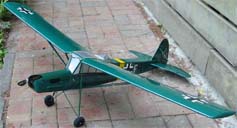
Dear Ken,
Thought you might care to see some photos of my little 400 size semi scale Fieseler Fi 156 "Storch". This can only be described as cartoon scale as Chris Golds so aptly puts it. Nevertheless I'm very happy to report that it flies beautifully and with heaps of spare power, so much so that my next trick is to try and learn to slow it down.
More than a few changes to the genuine Fieseler design were made to make it more practical for this type of sport flying on what I'd thought might be marginal power, I was wrong about the amount of power! The fuselage was slimmed down a bit, the wing flappery and spoilers deleted and the undercarriage simplified. I wound up with a model that considering it's size (52 inches span) only weighed 28 ounces ready to fly. It is however instantly recognizable so I guess that my original intent was met. The interesting bit is that despite retaining a good portion of that distinctive undercarriage and the wing struts it glides well and surprisingly flat. So much so that when I cut the power at about 50 feet well out beyond the end of our power strip on a windless day the model still went by me at well over head height and with little sign of slowing down. I was incidentally about half way along the strip at the time so on that occasion it was decidedly un-Storch-like. In fact, if it were much cleaner I actually believe one could thermal the thing. I chose to model the U/C in the typical "dangly" position as that is how it would normally be seen in the air but this of course means that it isn't exactly user friendly landing on our strip with a couple of inches of grass cover. Come summer when we're back to a semi-smooth surface or on a tarmac strip it would probably be OK but at this moment all it wants to do is flip over which is no great drama considering the low weight involved. Alternatively I might learn to improve my flying and drag it in to just dump it the last few inches in a three pointer but frankly I think I need a little breeze to help me with that.
Decals were simply cut from trim film and I confess to using a purely sport color scheme because the film was in my covering materials box. The basic mechanical spec' at the time of writing is:
Motor Jamara HS 480 coupled to a Hi-mark 3:1 spur gearbox and Graupner * X 4 Slim prop'. Power comes from 10 X 600 AE cells via a Jeti 20 amp ESC.
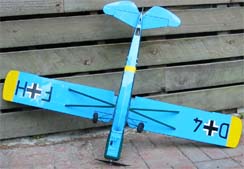
The power in hand is such that it virtually requires no throw to hand-launch it but simply flies away in a steady climb. This indicates that a move to 8 cells might work but I will try fiddling with cells, gear ratio's and prop' sizes but at least I don't have to rush to do it. Not a bad thing when I've got so many other projects to fill the brain. If, and only if enough people are interested I will do some drawings other than the chicken scratches I normally work from so let me know.
Regards from Australia,
David Hipperson
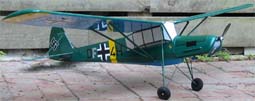 Return to "What's In This Issue?"
Return to "What's In This Issue?"
Multi-bladed Prop Question
From: James Frolik jdfrolik@freenet.de
The following is a post I made to the E Zone's Discussion Group under Power Systems. Maybe you could make a helpful comment. I read your October Ampeer -- oh, and I subscribed to Fly RC for one year -- and tried to again garner your Reviewing the Reviews column. Mostly, I was trying to absorb the mathematical parts of the plane's power needs. But, frankly, I'm still somewhat out to lunch with power system calculations. I've played around with eflight long enough to mostly know what will or could work, and what won't. But it's a different ball game when considering a 5-blade prop...
Regards,
James Frolik
Absolutely. I've copied your questions/comments here so that others may be able to contact you and the Ampeer with information regarding multi-bladed props. This is an area that I have NO personal knowledge with, except for some 3-bladed prop experiments that I did back in my glow flying days. I see 3-bladed props being used on some slow fliers. They seem to work okay, but to me they are relatively large diameter, slow turning props. I'd love to know more about multi-bladed props use. Jim's posting is below. KM
5-Blade varioPROP and Motor Gearing
I am seriously considering building a twin-motor Shorts 360 from plans. Basic specifications:
Wing span: 1.64m
Length: 1.44m
Wing area: 30dm2
Weight: appr. 2.15kg
Wing loading: appr. 71g/dm2
Recommended power setup for this model is direct drive with either Permax 480s or Permax 450s, 6x4 or 6.5x4 props and 8 or 9 x 1.7 to 3.0mAh cells.
I would like to create a more scale appearance and use 5-blade varioPROPs with 7.2-inch diameter blades. Of course this will require a gearbox. I plan to use Speed 480/7.2v Race motors.
The question is: What's the best gearbox ratio? I also want to keep the cell count at 8 to 10.
I've had some discussion with Christian Ramoser, maker of the varioPROP. He believes the 5-blade/7.2-inch diameter version would perform best at around 5000rpm and about 6-inch pitch. This would more-or-less require a high gear ratio, and to keep the amps down he thought a 4:1 would be a good starting point. Fine. But there's nothing out there like that for a 480 motor.
Cosmotech does make a 4.5:1 inline gearbox for a 480, and that appears okay. But the maximum wattage input for this gearbox is 100W. I'm somewhat inept when it comes to reckoning such calculations, but with a 5-blade prop 100W sounds low to me.
Kruse makes a wonderful offset gearbox for a 480 that is rated up to 350 Watts. Sounds good. But the maximum gear ratio is 3:1.
Graupner sells an inexpensive (but good) inline gearbox for 480 with a 3.45:1 ratio. But I can't find any maximum wattage specifications on this unit. Graupner also makes a Speed 400/7.2v motor with 4:1 inline gearbox, but Christian and I believe this just won't offer the power needed at manageable amperage for a 5-blade prop. (A 4-blade varioPROP could be substituted, but then the plane's scale look will fail.)
With the above information, can anyone suggest an alternative gearbox to use with a 480 motor in this model? Or is the [100-watt] Cosmotech adequate for my need? Comments appreciated.
Note: the 5-blade prop will pull like a horse. I just need strong enough reins.
Return to "What's In This Issue?"
4-Channel Recommendation
From: Kent Williby kwilliby@yahoo.com
Ken,
In the November Ampeer I saw a request from someone asking for suggestions for a 4-channel Sport model. I've been following a couple of threads on the Ezone for two of Bill Stevens kits. One is called the Groove which is a 45" span low wing sport plane. The other is his new 55" Cap. Both planes look great. Bill laser cuts his own kits and the quality looks excellent. I myself love building and will be purchasing one of Bill's kits in the near future. Take a look at his website at www.stevensaero.com. The threads on the Ezone can be found in the 'sport plane' section. Search for Stevensaero or Groove.
Return to "What's In This Issue?"
Servos & 4-Channel Recommendation
From Bernard Cawley, Jr bernard.e.cawley@boeing.com
Time for my almost monthly comment back, I think.....
LOTS of good stuff in this (Nov.) issue. I found the servo testing article particularly enlightening and timely as there has been a discussion on the Ezone between a local friend of mine and Peter Berg about problems with Peter's marvelous little microStamp 4 channel receivers which was ultimately traced to a Hitec Flash 5 transmitter putting out pulse widths way outside the boundaries of what is considered normal. I think Hitec is in for some trouble with digital servos and Flash transmitters......you can see the discussion here: www.rcgroups.com/forums/showthread.php?s=&threadid=156649
On the 4 channel sport model discussion-calculations... my first comment is that Jim is selling the LT-25 short by saying "flat bottomed wing". It has the REAL Clark-Y (as Keith Shaw so likes) so is not handicapped as Jim seems to think by that.
A turnkey LT-25 setup would be an AXI 2820/10, 11X7 APC-E and a Thunderpower 3s4p pack. I think this combo would give 1:1 thrust to weight and I know it would fly for 25 minutes - I'm flying a bigger airplane, propped with a 12X6, on the same motor for 25 minutes with my big TP pack (that's about 440W at full throttle and really pushing that little motor to the max). But the LT-25 is bigger than he wants and with a $200 battery isn't cheap. Of course he'll also need an appropriate charger (I heartily recommend the new Astro Flight 109 for this). For a smaller model as you're suggesting, and especially at the relatively low currents of a 3s2p TP2100 pack (good for SHORT bursts to 40A and maybe 24A sustained) a smaller member of the AXI family might be as good or better such as the 2814/12. But, to use it to its best ability would mean going to 3p on the Thunderpowers (propping for low 30s).
Finally, you are not alone in being dismayed at Sig's non-response to your comments about the "Nitro Rascal" ads. I know of a couple of other well-known names that you also know who have had similar results. I've tried writing letters to magazine editors, but of course they're caught in the middle in this, really. I DO plan to write to Rob Kurek and Bob Hunt at Model Aviation about this - I was REALLY surprised to see the ad in MA (less so in other publications where it's appeared). I sure hope they hear us, even if they're not responding. I was relieved to see that that ad wasn't one of Sig's three in the December MA that came yesterday.
Take care.
Bernard Cawley, Jr.
Return to "What's In This Issue?"
SuperStar EP Comment
From Bernard "Crash" Siegel crashsiegel@yahoo.com
Ken,
My son and I have the SuperStar EP. It is modified as per LVRCFlyer's thread on Ezone (Endo, gearbox, large prop, TP 2S4P 7.8Ah LiPo). I also extended the landing gear a bit due to the large prop, and replaced the Tamiya (!) connectors with proper APP and used both straps for the battery.
It's great!
So far we (Father, son and son's instructor) have not been able to run a pack out of juice. We run out of "juice" before it does! Longest continuous flight is over 40 minutes.
Jeremy is slowly getting the hang of it. At first each session he tends to over-control then settles down. I find it a good flyer but, as you noted, do keep the speed up a little. And as you suggested a little more dihedral might be good. ROG's (paved runway) and lands fine except it needs a steerable tail wheel. For the price, not bad.
We still haven't broken it yet!
Thanks and keep up the good work,
Bernard "Crash" Siegel
San Antonio Prop Buster - Eflight Fanatic
Return to "What's In This Issue?"
RBC Kits Update
From: Rob Bulk info@rbckits.com
(All Photos From RBCkits Web Site)
Hello Friends,

The Birddog is available now, it was a lot of work, but here it is. In the kit are all items you need to build the Bird, including: Pre-bent landing gear, waterslide decals, and all small items. Large 1:1 cad drawing, photo instructions etc.
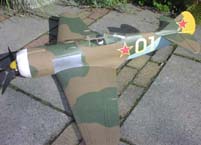
Soon we will have the LA5 Russian WW2 Warbird in the collection, flight tests have been very successful with a speed 600 and 10 cells CP1300. It's even better with the Typhoon 15 and 10 cells CP1300.
The LA5 can be expected in December 2003.

Also soon available the Halair Mig29 as a kit from RBCkits. We need some time to make minor changes to the design, as balsa wings instead of foam and a complete drawing has to be made, expected in December /January.
As a lot of people know there are the New Brushless outrunners from High-end Technology. We have embraced these motors as they are light, cheap and powerful. All of our prop driven models will be converted to take the Typhoon motors.
The Typhoon 6 is a very powerful replacement for the 400 geared. See the El Toro movie on the homepage to get convinced.
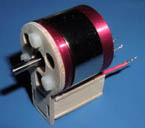
We have just tested the Typhoon 15 in the new LA5, and it was above expectations with a powerful start and a speedy flight. The Typhoon 15 fits in the Warbirds with only a replacement of the gearbox holder as delivered by the Warbirds.
The introduction period ends at Christmas and prices will be a bit higher then, so get them now, we ship everywhere.
We will also be converting the older kits to the take separate servo's for ailerons and upgrade them to take the new motors.
Please have a look at the homepage and enjoy.
If you have any questions, do not hesitate, we answer them.
Greetings and have a nice day
Rob Bulk
www.rbckits.com
RBC kits can be obtained from Classic Flying Machines www.classicflyingmachines.com KM
Return to "What's In This Issue?"
Where I get my Supplies
By Ken Myers
I'm often asked where I find certain items that I use in our hobby. One of my main sources is E Cubed R/C run by Azarr. He has a lot of very useful items. One of my "prized" and most useful tools is the Anderson Power Pole Crimper. No it's not cheap, but, to me, worth every penny! Azarr keeps all sizes of APC "E" Props, APC Slow Fly, and APC Folding Props & Hubs in stock at all times.
He is also a good source for motor mounts. He has two types of mounts for the outrunner AXI 41xx/xx Series motors. One is a radial-type mount and the other is a bracket-type.
 

All photos from E Cubed Website. KM
He has mounts for the small Hacker and Mega motors, as well as the S400 mount from Maxx Products. They are shown Hacker left, Mega right and Maxx Products below.
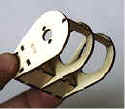 
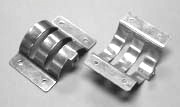
Photos from E Cubed Website. KM
If you are looking for; Azarr antennas, chargers, connectors, control horns, crimper, gearboxes, kits & plans, lighting systems, Loctite, brushed and brushless motors, motor mounts, name tags, prop adaptors, props, S400 mounting screws, speed controls, tools, thermometer, Ultimate Bec, weather instruments, wheels (HL "LYT"), or wire, check out Azarr's selection at: www.ecubedrc.com.
He can also be reached at:
1750 Lundgren Road
New Carlisle, OH 45344
Phone: 937-849-0418
Fax: 937-849-0341
Email: info@ecubedrc.com
Return to "What's In This Issue?"
We've Lost Some E-flight Friends
Howard Chevalier
Information Provided by Greg Judy and the DEAF Notes Newsletter
On October 21, 2003 Howard Chevalier passed away peacefully from an extended bout with cancer and multiple cardiac issues. The funeral was held in Bryan, Texas.
Folks that knew Howard quickly learned that he was quite a character and sometimes sorta ornery! We had a lot of fun when he visited us (DEAF) over the years at our meetings and fly-ins. I think I even crashed a sailplane into him one time, but that's another story. He was a retired aeronautics professor at A&M and used his background to build and design models. Howard's title was ‘Professor Emeritus of Aerospace Engineering' at Texas A&M. I know he wrote several books on aircraft theory and how to put it to use for modelers. We will indeed miss Howard!
I meet Howard when I CD'd the Electric Nationals in Muncie, IN in 1996. As Greg said, he did have a reputation of being sorta ornery, but I found him to be a very interesting individual. I felt very fortunate to have a several hour conversation with him, one on one. We were the only two camped there that year. We sat under the stars and talked just a little about model airplanes and a lot about life, the stars and the universe. It was one of the greatest and most memorable experiences of my life. KM
Al MacDonald
Information from the November 2003 Electric Model Flyer of the EMFSO
Sadly, editor, Al MacDonald passed away on August 31st from a heart attack. As you know, Al contributed significantly to the EMFSO over the years. He particularly enjoyed maintaining the newsletter and the original Web site. He will be missed.
Al and I corresponded over many years, and for those of you paying attention to the credits in the Ampeer and Electric Model Flyer, you may have noted that we "swapped" more than a few articles. There has been a very close relationship between the EFO and the EMFSO over almost two decades now. Yes, he will be missed. KM
Return to "What's In This Issue?"
WHERE FOR ART THOU AMPS?
By Frank Korman - FSKorman@aol.com
via DEAF Notes, November 2003
Dang, my Great Planes Fundango seemed reluctant to tango; aerobatically that is. A loop from level flight with a freshly charged battery was a struggle even though the "Dango" was powered as suggested (Speed 400-6v, geared 3:1, 10x7 prop, and 8 NiMH cells). I tried an 11x8 prop, but no improvement. Sooo, I plugged in my trusty ammeter and found that 10 amps max was being drawn, and only for a few seconds as the amperage dropped to 9 or less very quickly.
Hmmm "What could be the cause?" I focused on the motor as a few of my buddies, using the same brand of S-400, reported anemic power. Sensing easy victory I swapped out the suspected motor for one I knew was a 6-volter (per label and experience). But plugging in the meter showed very little change with the ten or eleven inch prop.
Next suspect the battery, a new "no-name" 8-cell, 1000ma, NiMH pack. So I plugged in an 8 cell, 1900ma NiCad pack. Twelve to 13 amp-draw. OK, finally I plugged in a friend's 8 cell, HE1100, NiMH pack and again read 12 to 13 amps. My "cheap" NiMH pack was the culprit, and I kicked myself for not checking it before trading out motors.
We often read how electric power has become a simple plug and play proposition. I wonder about that.
Consider the following as possible causes for (low) amp draw problems.
Prop: Wrong diameter, and/or pitch. Sub-optimal shape or airfoil. Unbalanced.
Gearbox: Wrong ratio. Dirty, draggy (improperly gapped) gears. Pinion gear slipping on motor shaft.
Motor: Unsuitable voltage for desired application. Bent motor shaft. Worn out brushes. Incorrect timing. Lack of capacitors from terminals to case and across terminals. Positive and negative wires soldered to incorrect terminals.
Speed Control: Unsuitable for desired application (low amp and/or voltage rating). Not programmed properly to transmitter throttle control. Lack of diode in controller or across motor terminals.
Battery Pack: Not completely charged. Incorrect number of cells. Desired amp draw beyond packs "comfort zone" (my problem). One or more sick cells. Poor connector contact. Too small and/or too long power wires.
I'm sure y'all can think of other reasons for actual amp draw not in line with what is needed, or predicted. Unlike me, I hope you'll keep it simple when hunting the cause of power problems. Frank S.
Return to "What's In This Issue?"
Oakland Yard
4th Annual Reindeer Fun Fly!
Saturday, December 27th, 2003
Bring out your new holiday toys for their first flight!
Aviation Director, David Dobrin, will organize festivities with the 'free flight' models from 6:00 to 8:00 p.m. From 8:00 to 11:00 p.m., the electric RC planes will take to the sky.
The first 40 children will receive their own hand-launched glider to build, fly and keep.
The kids' flying time will run from 7:00 to 8:00 pm. After the 'free flight' portion of the evening, children are welcome to stay to watch the radio control planes. As featured last year, the RC Zagi's will be dog fighting around 9:00 p.m.
 Return to "What's In This Issue?"
Return to "What's In This Issue?"
To Reach Ken Myers, you can land mail to the address at the top of the page. My E-mail
address is:
KMyersEFO@aol.com
EFO WEBsite: http://members.aol.com/KMyersEFO/
|
|

















